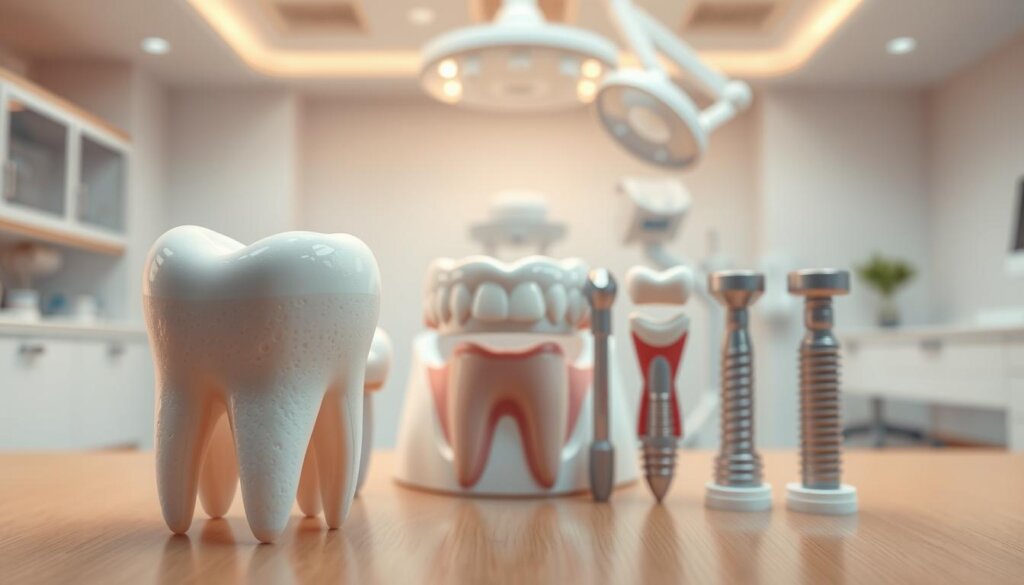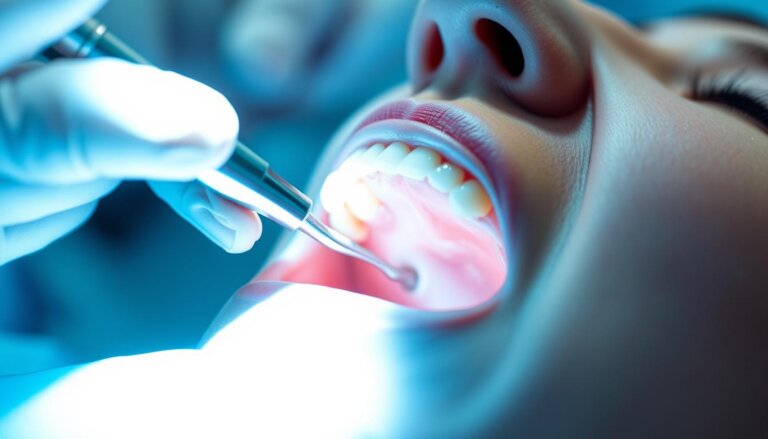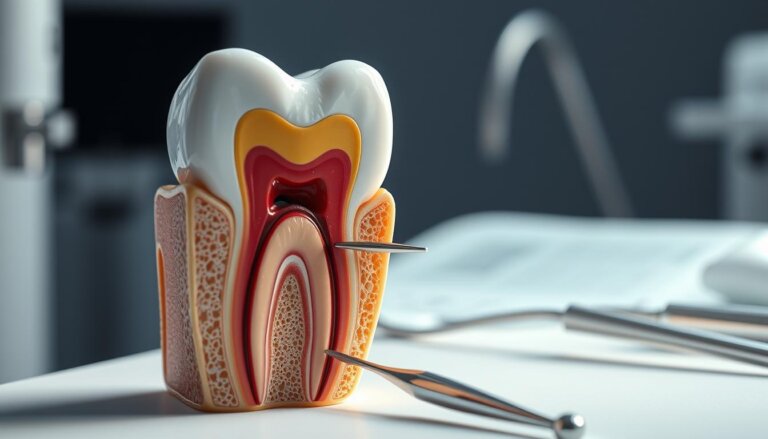Root Canal or Tooth Extraction: Which Is Best?
Every year, about 15 million root canal treatments happen in the U.S. This shows that people usually try to keep their natural teeth.
When a tooth is at risk from decay or infection, a big question is: should you get a root canal or have the tooth pulled? A root canal cleans out the infected pulp and seals it. On the other hand, tooth extraction removes the whole tooth. Both options aim to get rid of the infection and keep your mouth healthy.
Key Takeaways
- Root canals target infected pulp to save the tooth
- Extractions are recommended when severe decay weakens the tooth
- Each method seeks to eliminate harmful bacteria
- Dentists evaluate tooth structure before suggesting treatment
- Asking, “Is it better to get a root canal or just pull the tooth?” shapes a vital care decision
Understanding Dental Pain: Signs You Need Care
Toothaches can be mild or severe. Some go away quickly, but others last longer and mean something serious is wrong. Knowing these signs helps you get help fast.
Seeing pain early can stop bigger problems. Feeling pain when you bite or having a constant ache means you need to see a dentist. It’s smart to think about root canal vs tooth extraction before things get worse.
When to Consult a Dentist
Severe pain, swollen gums, or being very sensitive to cold or hot water means you need a dentist. A dentist can tell if the tooth is in danger or if it’s just a minor issue. Getting help early can avoid bigger problems.
Common Causes of Tooth Pain
Some things can cause tooth pain:
- Untreated cavities that reach the inner layers
- Fractures exposing sensitive nerve tissue
- Gum disease advancing into deeper structures
- Pulp inflammation leading to infection
Finding out why you have tooth pain helps decide if you need a root canal or tooth extraction.
The Root Canal Procedure Explained
Root canal therapy saves a tooth from deep decay or pulp infection. It’s a key dental option to keep your natural tooth and support your mouth’s function for years.
What Happens During a Root Canal?
An endodontist numbs the area with local anesthetics. Then, they remove the infected pulp from inside the tooth. They use files to clean the canals, getting rid of hidden bacteria and debris.
After, they place a protective material to seal the canals. This helps prevent the tooth from getting infected again.
- Numbing with anesthetic
- Accessing the pulp chamber
- Cleaning and disinfecting the canals
- Sealing and restoring the tooth
Recovery After a Root Canal
You might feel some soreness or sensitivity for a short time. But most people can go back to their usual activities right away. If you need to, you can use over-the-counter pain relievers.
Regular check-ups with your dentist are important. They help make sure your tooth stays healthy and supported.
| Stage | Process | Goal |
|---|---|---|
| 1 | Anesthetic Application | Painless Experience |
| 2 | Pulp Removal | Eliminate Infection |
| 3 | Canal Cleaning | Remove Bacteria |
| 4 | Sealing | Prevent Reinfection |
Tooth Extraction: What to Expect
Dentists check how bad the decay is, where the tooth is, and the tissue around it before suggesting removal. Some people feel a lot of pain, while others just feel a little pressure as the tooth comes loose. The main goal is to stop the inflammation and protect the jaw from more harm.
Many wonder if taking out a bad tooth is easier than other treatments. Today, there’s a big push to saving natural tooth in dental care. But, if the tooth is too damaged or the infection is too severe, extraction might be the best choice.
Types of Tooth Extractions
There are different ways to remove teeth, depending on the tooth’s condition. Simple extractions are for teeth that are fully out and not damaged. Surgical extractions are needed for teeth that are stuck or broken under the gumline.
| Extraction Type | Key Considerations |
|---|---|
| Simple Extraction | Used for visible, intact teeth with fewer complications |
| Surgical Extraction | Involves incisions and sutures for impacted or broken teeth |
Healing Time for Tooth Extractions
Clots usually form in the first 24 hours. Gentle rinsing helps keep the area clean. Doing less activity helps reduce swelling, and pain usually gets better in a few days. Teeth that are missing can move, showing why saving a tooth is important.
Comparing Root Canals and Tooth Extractions
Choosing to save a tooth can avoid more complex procedures later. Yet, in some cases, removing the tooth is the best option. Dentists consider many factors to find the best treatment for your tooth pain and oral health.
Pros and Cons of Root Canals
Many see root canals as a key treatment for tooth pain. They keep the natural tooth, reduce pain after the procedure, and help keep the jaw aligned. While it might need more visits and cost more, the long-term benefits are worth it.
Pros and Cons of Tooth Extractions
Extracting a tooth can quickly solve infection issues. It’s a simple procedure with fewer follow-ups. But, it might lead to changes in your bite or jaw later, needing more treatments like implants. These additional steps add to the cost and planning.
When comparing, think about how complex the procedure is, how long it takes to heal, and how long the results last. The table below highlights key differences:
| Factor | Root Canal | Tooth Extraction |
|---|---|---|
| Procedure Complexity | Pulp removal, cleaning, and sealing | Simple removal in many cases |
| Recovery Time | Shorter healing period, mild soreness | Possible extended downtime, risk of gaps |
| Long-Term Outcome | Preserves natural tooth, stable bite | May require implants or bridges |
Cost Considerations: Root Canal vs. Extraction
Many patients consider both options for tooth decay treatment. Costs vary by location and the dentist’s skill. The complexity of the procedure and any needed follow-ups affect the price, leading to big differences in costs.
Factors Influencing Treatment Costs
Root canals might need crowns, increasing the cost. Extractions could lead to implants or bridges, adding to the long-term expenses. Several factors play a role:
- Dentist’s credentials and equipment
- Procedure complexity and duration
- Clinic location and fee schedules
Insurance Coverage Comparison
Insurance can cover more for root canals or extractions. Sometimes, what’s covered can make one option more appealing. Dentists help patients understand their insurance. This way, people can choose a treatment that fits their budget without compromising their dental health.
Long-Term Dental Health: Root Canal or Extraction?
Choosing to keep or remove a damaged tooth is key to long-term oral health. For some, endodontic therapy can save the tooth and keep the jaw strong.
Risk of Tooth Loss with Extractions
When a tooth is pulled, other teeth might move and bone can shrink. This can lead to gaps and affect how teeth fit together. Dentists carefully consider these risks before recommending removal.
Maintaining Oral Health After Both Procedures
Good oral hygiene is essential. Brushing, flossing, and rinsing daily keeps gums healthy. Regular dental check-ups are also important to catch problems early.
People who get endodontic therapy or have teeth pulled should eat foods full of nutrients. These help keep gums strong.
| Recommended Care Step | Suggested Frequency |
|---|---|
| Professional Dental Cleanings | Every 6 Months |
| Fluoride Rinse | Daily after Brushing |
| Routine X-Rays | Once a Year |
Potential Complications from Both Procedures
Any treatment for infected or damaged teeth can have unexpected problems. Dental teams work hard to prevent these issues. It’s important for patients to know what might happen and ask questions.
This knowledge helps make safer choices and sets realistic expectations.
Possible Risks of Root Canals
At times, bacteria can cause ongoing pain or more visits. Teeth might crack or split if damage is deep. But, a successful root canal can fix this by strengthening the tooth.
Risks Associated with Tooth Extractions
Every extraction needs time and care to heal properly. Protecting the clot is key to avoid problems. Dry sockets can happen if the clot goes away too soon.
Antibiotics or gentle mouthwashes can help. They show the benefits of tooth extractions in preventing infection.
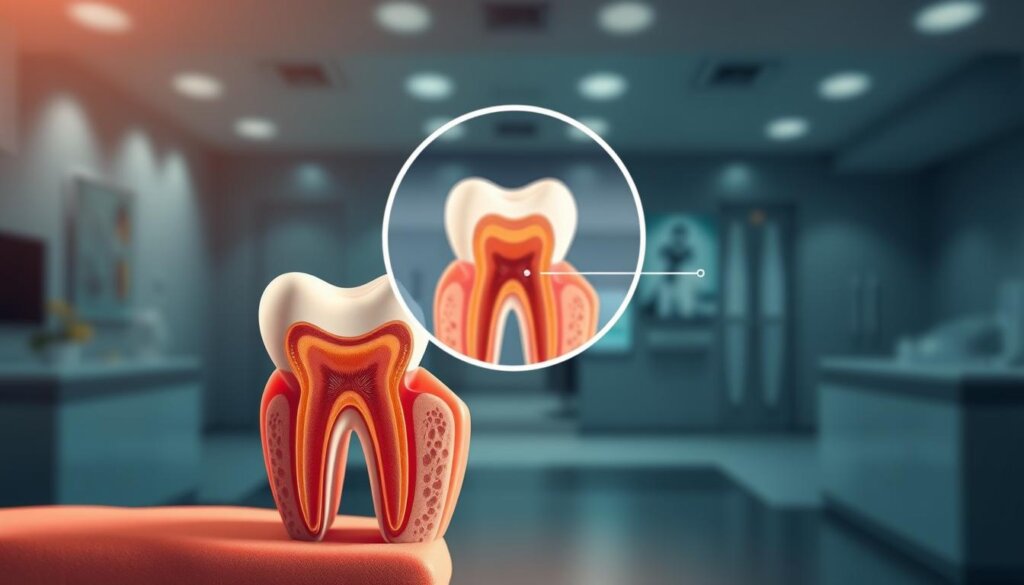
- Preventive medications lower infection risks
- Closely follow your dentist’s aftercare guidance
| Potential Issue | Preventive Measure |
|---|---|
| Infection | Timely antibiotic use and sterile techniques |
| Tissue Trauma | Accurate surgical methods and gentle handling |
| Pain Management | Analgesics and monitored healing |
Alternatives to Root Canals and Extractions
Some people find less invasive ways to keep their teeth. Options include special fillings and new materials to protect teeth. Early treatment can save more of the natural tooth.
This approach can make teeth more comfortable and last longer.
Dental Crowns and Other Treatments
Crowns cover weak enamel to prevent cracks. Resin inlays and partial endodontic therapy strengthen teeth. These options are for those who don’t want big procedures.
They work well if the tooth has enough healthy parts left.
When Are Alternatives Appropriate?
Conservative dentistry focuses on gentle methods. Important factors include:
- How bad the decay is
- The health of the tooth’s surroundings
- How well you take care of your teeth
These alternatives are best for those who stick to regular dental visits.
| Option | Benefits |
|---|---|
| Dental Crown | Offers strong coverage and aesthetic appeal |
| Resin Inlay | Preserves more original tooth material |
| Partial Endodontic Therapy | Treats localized infection without full removal of pulp |
Dental Anxiety: Overcoming Fear of Procedures
Many people feel nervous when they need to get dental work done. A calm place and clear explanations can help. Techniques like breathing exercises or light sedation can also make them feel more at ease.
When dealing with big dental problems, people often wonder: Is it better to get a root canal or just pull the tooth? Choosing the right dentist is important, but overcoming fear is also key. A caring dental team and open talk can make even tough procedures feel more manageable.
Here are some ways to handle dental anxiety:
- Distraction methods such as music or guided imagery
- Relaxation tools like meditation to calm racing thoughts
- Speaking with the dentist beforehand to clarify each step
Feeling comfortable with your dentist makes it easier to get the care you need. Looking into their credentials, reading what others say, and visiting them first can help. This way, you can feel more confident about your oral health.
How to Prepare for Your Dental Appointment
Going to the dentist can be new and important. Knowing what to expect helps you feel more at ease. Learning about costs, how long it takes, and the choice between root canal and tooth extraction makes your visit better.
Questions to Ask Your Dentist
Talking clearly with your dentist is key. Write down your questions before you go. Ask about:
- How many visits are needed for treatment?
- Which pain management options are available?
- How does insurance coverage vary?
- What is the suggested follow-up schedule?
Necessary Pre-Treatment Assessments
Diagnostic images and exams help the dentist plan your treatment. They might use X-rays, look at your medical history, and do tests. These steps help decide if you need a root canal or tooth extraction.
| Assessment | Focus |
|---|---|
| Diagnostic Imaging | Reveals infection depth and root integrity |
| Health History Review | Identifies underlying conditions |
| Physical Exam | Checks gum and tooth structure |
The Role of Nutrition in Oral Health
Diet affects teeth more than you might think. Eating balanced meals with vitamins and minerals helps keep enamel strong and gums healthy. This is key for healing after procedures like root canals or tooth extractions.
When looking at dental options, it’s important to know which foods help with healing and prevent infections. Eating foods rich in nutrients is a big part of keeping teeth healthy and avoiding problems.
Foods that Support Tooth Health
Calcium-rich foods, leafy greens, and lean proteins help repair and strengthen teeth. Vitamin C keeps gums strong, and healthy fats help carry nutrients. These foods fight off bacteria and protect teeth.
Nutrition Post-Procedure
After dental work, eating soft foods helps with healing. Try blended soups, soft fruits, and pureed veggies. These foods are gentle on sore areas and help your body recover faster.
“The American Dental Association recommends foods high in vitamins A and C for optimal gum repair.”
Follow-Up Care After Treatments
After dental procedures, keeping up with care is key. The aim to saving natural tooth structure is best met with follow-up visits and expert advice.
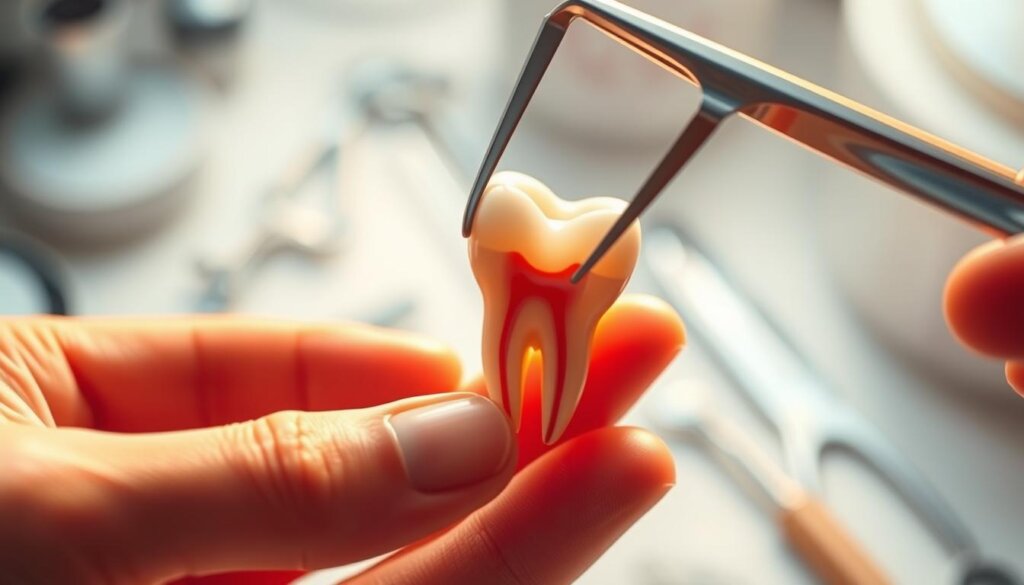
Regular check-ups are essential for tracking healing and tweaking plans if needed. X-rays and cleanings can spot issues early.
Importance of Regular Check-Ups
These visits help keep you comfortable and your teeth working right. Dentists check on gums and bites to make sure everything fits well. Regular visits help keep your mouth healthy and support healing.
Signs of Complications to Watch For
- Lingering discomfort or inflammation
- Persistent sensitivity to temperature
- Unusual swelling near the site
| Visit Timing | Focus | Possible Actions |
|---|---|---|
| 1-2 Weeks Post-Treatment | Early Healing Check | Minor Adjustments or Cleanings |
| 3-6 Months | Long-Term Stability | Further X-rays or Bite Evaluation |
| Annual Check-Up | Ongoing Monitoring | Preventive Care and Restorations |
Making Your Decision: Root Canal or Extraction?
Choosing between a root canal or extraction depends on the tooth’s health and your goals. You might think about how long the tooth will last, possible problems, and the cost. Saving your natural tooth is often the preferred choice.
Factors to Consider in Your Choice
Some people choose root canals to keep their teeth stable and avoid more work later. Others might pick extraction if their tooth is badly damaged. Your medical history, how your body reacts to treatments, and how quickly you want to recover are important. These factors help you feel sure about your choice.
Consulting with a Dental Professional
Dentists and endodontists look at X-rays and talk about how well treatments work. They help you make a choice that’s right for you. They also suggest regular check-ups to catch problems early.
| Key Factor | Reason |
|---|---|
| Extent of Decay | Deep infections call for advanced therapies |
| Tooth Structure | Sufficient enamel supports a root canal approach |
| Financial Variables | Insurance and cost concerns affect final decisions |
Final Thoughts on Dental Procedures
Root canal therapy and extraction are key in today’s dental care. They help with pain, infection, and keeping teeth healthy. Dentists, like those from the American Dental Association, say working together is best.
Things like your dental history, what you want to look like, and money matters shape your treatment plan. This makes care personal and effective.
Weighing Your Options
Think about the good and bad of any tooth treatment. Root canals aim to keep your smile natural. But, if a tooth is too far gone, extraction might be the better choice.
After a tooth is pulled, you might need implants or bridges to keep your teeth in line. It’s important to think about what you need and what you can afford.
Prioritizing Your Oral Health
Preventive care and regular dental visits can prevent big problems later. Good habits help your gums and teeth stay strong. This lowers the chance of needing complex treatments.
Finding a dentist who knows your short-term and long-term goals is important. With consistent care, your smile can stay healthy for years.

